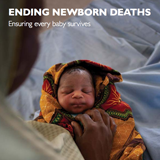
Executive Summary
The world has made remarkable progress in the fight to end child mortality in recent years. Since 1990, we have almost halved the number of children who die every year before the age of five – from 12.6 million to 6.6 million.1
This amazing achievement – even more impressive given that the populations in the poorest countries have grown by 70% during this period2 – allows us to start to imagine a world where no child is born to die from easily preventable causes.And yet, in spite of this progress, child mortality remains one of the great shames of our modern world. Every day, 18,000 children under five die, and most from preventable causes.
Newborn Crisis Threatens Progress
This reduction in child mortality has been achieved through action on immunisation, family planning, nutrition and treatment of childhood illnesses, as well as improving economies. however, far less attention has been paid to tackling the life-threatening dangers children face when they are newborn and most vulnerable – at birth and in their first month of life.
This report shows that, in 2012, 2.9 million babies died within 28 days of being born: two out of every five child deaths. of these, 1 million babies died within 24 hours, their first – and only – day of life.3 Causes of these deaths include premature birth, complications during birth and infections. This is heart-breaking and unacceptable.
Unless we urgently start to tackle deaths among newborn babies, there is a real danger that progress in reducing child deaths could stall and we will fail in our ambition to be the generation that can end all preventable child deaths.
This report also reveals that the crisis is much bigger than we might think. in 2012 there were another 1.2 million tragic losses: stillbirths where the heart stopped beating during labour. These are not part of the fourth UN Millennium Development goal, which aims to reduce child mortality by two-thirds. however, they deserve to be counted in future maternal, newborn and child health frameworks, especially to understand the specific risks around labour and delivery. This report therefore focuses on the 2.2 million combined newborn deaths on the first day and stillbirths during labour.
There’s a huge amount at stake. As the 2015 deadline for the Millennium Development goals approaches, it is vital that the world acts to make sure more countries can get on-track to achieve MDG4. it has now become clearer we won’t be able to do this unless we urgently tackle the crisis of newborn deaths. We won’t be able to go further and to talk about ending all preventable child deaths unless essential healthcare is the reality for every woman and baby.